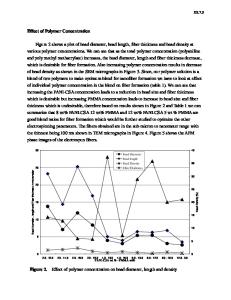Stereocomplex PMMA Fibers
- PDF / 3,126,560 Bytes
- 6 Pages / 612 x 792 pts (letter) Page_size
- 54 Downloads / 266 Views
0920-S03-01
Stereocomplex PMMA Fibers Matija Crne1, Jung O Park2, Shin-Woong Kang3, Satyendra Kumar3, and Mohan Srinivasarao2,4 1 School of Chemistry and Biochemistry, Georgia Institute of Technology, Atlanta, GA, 30332 2 School of Polymer, Textile and Fiber Engineering, Georgia Institute of Technology, Atlanta, GA, 30332 3 Department of Physics, Kent State University, Kent, OH, 44240 4 School of Chemistry and Biochemistry, Georgia Institute of Technology, Atlanta, GA, 300332 ABSTRACT We have utilized the fact that syndiotactic and isotactic Poly(methyl methacrylate) {PMMA} form a stereocomplex to spin semi-crystalline PMMA fibers. Our goal is to produce oriented semi-crystalline fibers with a high enough melting point to withstand atactic-PMMA processing conditions. We successfully developed stereocomplex PMMA fibers by wet spinning and gel spinning, and characterized their properties by means of differential scanning calorimetry, optical/electron microscopy, mechanical testing and X-ray crystallography. Stereocomplex fibers from gel spinning have highest melting points and polymer chain orientation, hence are the best reinforcing agents. We are currently working on producing self-reinforced composites using these fibers. INTRODUCTION Poly(methyl methacrylate) (PMMA) has been used in many industrial applications, including high-speed optic cables, teeth filling material, transparent sheets and bone cement, to just name a few. The long-term success of the bone prosthesis has been shown to be linked directly to the stability of the bone cement mantle. Various composites involving Kevlar [1], carbon fibers [2], titanium [3] and poly(ethylene) [4] fibers and other materials were made to improve these mechanical properties. However, many of these composites included reinforcing materials that were not biocompatible. In addition to that, poor interfacial adhesion between the reinforcing fiber and the PMMA matrix leads to nucleation sites for cracking. Both of these problems, namely poor biocompatibility and interfacial adhesion, could be solved by making a self-reinforced PMMA composite, as suggested and implemented by Gilbert and co-workers, who used atactic-PMMA [5]. Our aim is to develop better PMMA self-reinforced composites with much improved mechanical/fatigue properties by using stereocomplex PMMA fibers, which are crystalline and allow higher processing temperature, as reinforcing fillers. In this article we wish to report the spinning of PMMA fibers from a 1:2 mixture of isotactic and syndiotacticPMMA. These two polymers, which have identical repeat units but different tacticity, form a crystalline stereocomplex [6]. In contrast to atactic-PMMA, which is amorphous, the stereocomplex is a semi-crystalline polymer with a melting point of 172-237 ºC [7] [8]. As the glass transition of PMMA is 105 ºC, the high melting point provides a wide processing temperature range, where the fiber crystallinity and orientation should be preserved, while the surrounding polymer chains in the amorphous matrix, as well as the poly
Data Loading...











